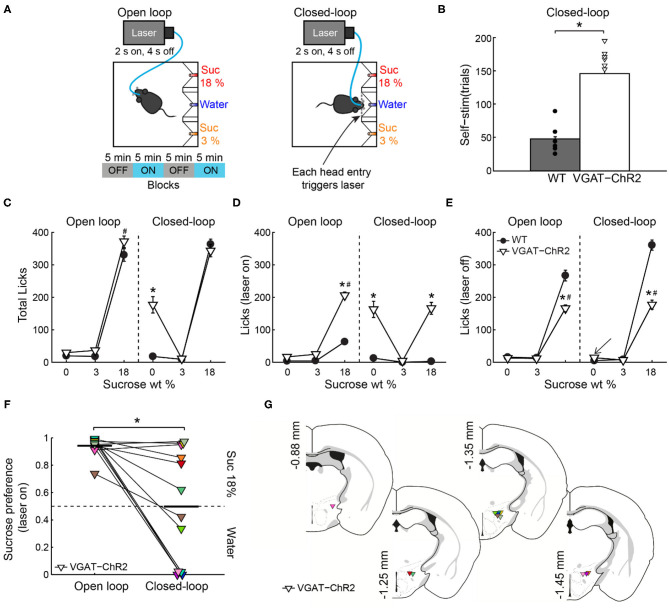Figure 7.
If stimulation occurred near the less palatable stimulus, LHAVgat+ neurons induced water intake despite sucrose. (A) For the open loop stimulation, the laser was activated (2 s on, 4 s off) regardless of behavior and mice position. The same mice and conventions as in Figure 5A. In the closed-loop configuration, the laser was triggered by a head entry in the central port. (B) The number of laser activations during the closed-loop protocol. The VGAT-ChR2 mice self-stimulate more than the WT mice. Each dot and triangle represent a single mouse. Unpaired t-test. (C) The total number of licks given for each stimulus during the entire session. In the open loop, both mice groups licked more sucrose 18% than water or sucrose 3%. However, in the closed-loop configuration, the VGAT-ChR2 consumed more water (0% sucrose) than the WT mice. (D) The number of licks evoked during 2.5 s after laser onset for each gustatory stimulus. (E) The number of licks when laser was turned off for each gustatory stimulus. (F) The water–sucrose 18% preference index from VGAT-ChR2 mice during photostimulation was defined as the number of 18% sucrose licks divided by the total licks for sucrose 18% + water. Thus, values higher than 0.5 indicate sucrose 18%, and values lower than 0.5 indicate preference for water. Some VGAT-ChR2 mice preferred water over sucrose. The horizontal black lines indicate mean preference in both stimulation protocols. Paired t-test. (G) Fiber optic location in the LHA of VGAT-ChR2 mice. *p < 0.0001 indicates a significant difference from WT mice and stimulation protocols. #p < 0.0001 between sucrose 18% and the other stimuli. Two-way ANOVA followed by the Holm–Sidak test.

